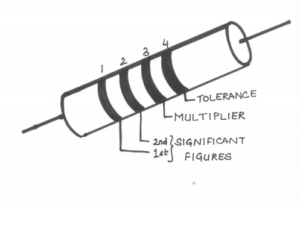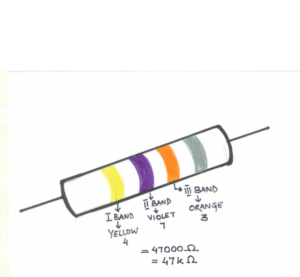We learnt some facts about Resistors in the previous blog. Now let us learn about the trick to read their value.
Some resistors are large enough to have their value printed on them. However, most of them are too small in size to have their value printed on them. Therefore, a system of colour-coding is adopted to indicate their value.
Each Resistor has some coloured rings on their body. Each colour corresponds to a specific number.
- The ring that is furthest from gold or silver ring is the first ring or the ring nearest to an end is the first ring.
- The first and second coloured rings corresponds to first and second digit of the value.
- The third ring indicates the multiplier or number of zeros that follow the second digit.
- The fourth band is usually gold or silver and represents the tolerance value. It is a measure of the precision with which the resistance is made.
The fourth band is usually gold or silver and represents the tolerance value. It is a measure of the precision with which the resistance is made.

FIGURE 1
The numerical value associated with each color is given in the table below:-
| Color | Digit | Multiplier | Tolerance |
| Black
|
0 | 1 | – |
| Brown
|
1 | 10 | – |
| Red
|
2 | 100 | – |
| Orange
|
3 | 10^3 | – |
| Yellow
|
4 | 10^4 | – |
| Green
|
5 | 10^5 | – |
| Blue
|
6 | 10^6 | – |
| Violet
|
7 | 10^7 | – |
| Grey
|
8 | 10^8 | – |
| White
|
9 | 10^9 | – |
| Gold
|
– | 0.1 | 5% |
| Silver
|
– | 0.01 | 10% |
| No colour | – | – | 20% |
| Mnemonics: As an aid to memory in remembering the sequence of color code, the following sentence can be remembered- |
| 1. B.B ROY Great Britain has a Very Good Wife. |
| 2. Bill Brown Realised Only Yesterday, Good Boys Value Good Work. |
Example: With the help of color code table, we will find the value of resistance:
1st band: Yellow
2nd band: Violet
3rd band: Orange
4rth band: Gold

Figure 2
*Picture Credits Vandana Razdan


Your article was very nice
Thanks
The article is good for us to read the value of resistor
Thanks for the article
I am truly floored by the comprehensive nature of your blog, and how easy it is to follow the instructions. So grateful that you are teaching my child!